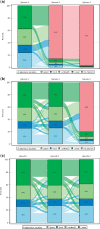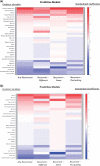Predicting Recurrent Care Seeking of Physical Therapy for Musculoskeletal Pain Conditions
- PMID: 33905514
- PMCID: PMC8502462
- DOI: 10.1093/pm/pnab154
Predicting Recurrent Care Seeking of Physical Therapy for Musculoskeletal Pain Conditions
Abstract
Objective: Musculoskeletal pain conditions are a leading cause of pain and disability internationally and a common reason to seek health care. Accurate prediction of recurrence of health care seeking due to musculoskeletal conditions could allow for better tailoring of treatment. The aim of this project was to characterize patterns of recurrent physical therapy seeking for musculoskeletal pain conditions and to develop a preliminary prediction model to identify those at increased risk of recurrent care seeking.
Design: Retrospective cohort.
Setting: Ambulatory care.
Subjects: Patients (n = 578,461) seeking outpatient physical therapy (United States).
Methods: Potential predictor variables were extracted from the electronic medical record, and patients were placed into three different recurrent care categories. Logistic regression models were used to identify individual predictors of recurrent care seeking, and the least absolute shrinkage and selection operator (LASSO) was used to develop multivariate prediction models.
Results: The accuracy of models for different definitions of recurrent care ranged from 0.59 to 0.64 (c-statistic), and individual predictors were identified from multivariate models. Predictors of increased risk of recurrent care included receiving workers' compensation and Medicare insurance, having comorbid arthritis, being postoperative at the time of the first episode, age range of 44-64 years, and reporting night sweats or night pain. Predictors of decreased risk of recurrent care included lumbar pain, chronic injury, neck pain, pregnancy, age range of 25-44 years, and smoking.
Conclusion: This analysis identified a preliminary predictive model for recurrence of care seeking of physical therapy, but model accuracy needs to improve to better guide clinical decision-making.
© The Author(s) 2021. Published by Oxford University Press on behalf of the American Academy of Pain Medicine.All rights reserved. For permissions, please e-mail: journals.permissions@oup.com.
Figures


Similar articles
-
Prevalence and predictors of no-shows to physical therapy for musculoskeletal conditions.PLoS One. 2021 May 28;16(5):e0251336. doi: 10.1371/journal.pone.0251336. eCollection 2021. PLoS One. 2021. PMID: 34048440 Free PMC article.
-
Prediction of Persistent Musculoskeletal Pain at 12 Months: A Secondary Analysis of the Optimal Screening for Prediction of Referral and Outcome (OSPRO) Validation Cohort Study.Phys Ther. 2018 May 1;98(5):290-301. doi: 10.1093/ptj/pzy021. Phys Ther. 2018. PMID: 29669081 Free PMC article.
-
Prediction of healthcare utilization following an episode of physical therapy for musculoskeletal pain.BMC Health Serv Res. 2018 Aug 20;18(1):648. doi: 10.1186/s12913-018-3470-6. BMC Health Serv Res. 2018. PMID: 30126409 Free PMC article.
-
The use of STarT back screening tool to predict functional disability outcomes in patients receiving physical therapy for low back pain.Spine J. 2019 Apr;19(4):645-654. doi: 10.1016/j.spinee.2018.10.002. Epub 2018 Oct 9. Spine J. 2019. PMID: 30308254 Free PMC article.
-
The impact of therapeutic alliance in physical therapy for chronic musculoskeletal pain: A systematic review of the literature.Physiother Theory Pract. 2020 Aug;36(8):886-898. doi: 10.1080/09593985.2018.1516015. Epub 2018 Sep 28. Physiother Theory Pract. 2020. PMID: 30265840
Cited by
-
Self-reported disability trajectories and their predictors among patients receiving care by physical therapists for musculoskeletal conditions: a retrospective analysis of registry data.BMJ Open. 2025 Jun 20;15(6):e099315. doi: 10.1136/bmjopen-2025-099315. BMJ Open. 2025. PMID: 40541444 Free PMC article.
-
Electronic Health Records for Predicting Outcomes to Work-Related Musculoskeletal Disorders: A Scoping Review.J Occup Rehabil. 2024 Dec;34(4):770-782. doi: 10.1007/s10926-024-10175-1. Epub 2024 Mar 27. J Occup Rehabil. 2024. PMID: 38536622 Free PMC article.
-
Movement Clearing Screens for Military Service Member Musculoskeletal Injury Risk Identification.J Athl Train. 2025 Jan 1;60(1):11-20. doi: 10.4085/1062-6050-0396.23. J Athl Train. 2025. PMID: 39007808
References
-
- Picavet HS, Schouten JS.. Musculoskeletal pain in the Netherlands: Prevalences, consequences and risk groups, the DMC(3)-study. Pain 2003;102(1–2):167–78. - PubMed
-
- da Silva T, Mills K, Brown BT, et al.Risk of recurrence of low back pain: A systematic review. J Orthopaedic Sports Phys Ther 2017;47(5):305–13. - PubMed
-
- Stanton TR, Henschke N, Maher CG, et al.After an episode of acute low back pain, recurrence is unpredictable and not as common as previously thought. Spine 2008;33(26):2923–8. - PubMed
-
- da Silva T, Mills K, Brown BT, et al.Recurrence of low back pain is common: A prospective inception cohort study. J Physiother 2019;65(3):159–65. - PubMed
-
- Hancock MJ, Maher CM, Petocz P, et al.Risk factors for a recurrence of low back pain. Spine J 2015;15(11):2360–8. - PubMed
Publication types
MeSH terms
Grants and funding
LinkOut - more resources
Full Text Sources
Other Literature Sources

